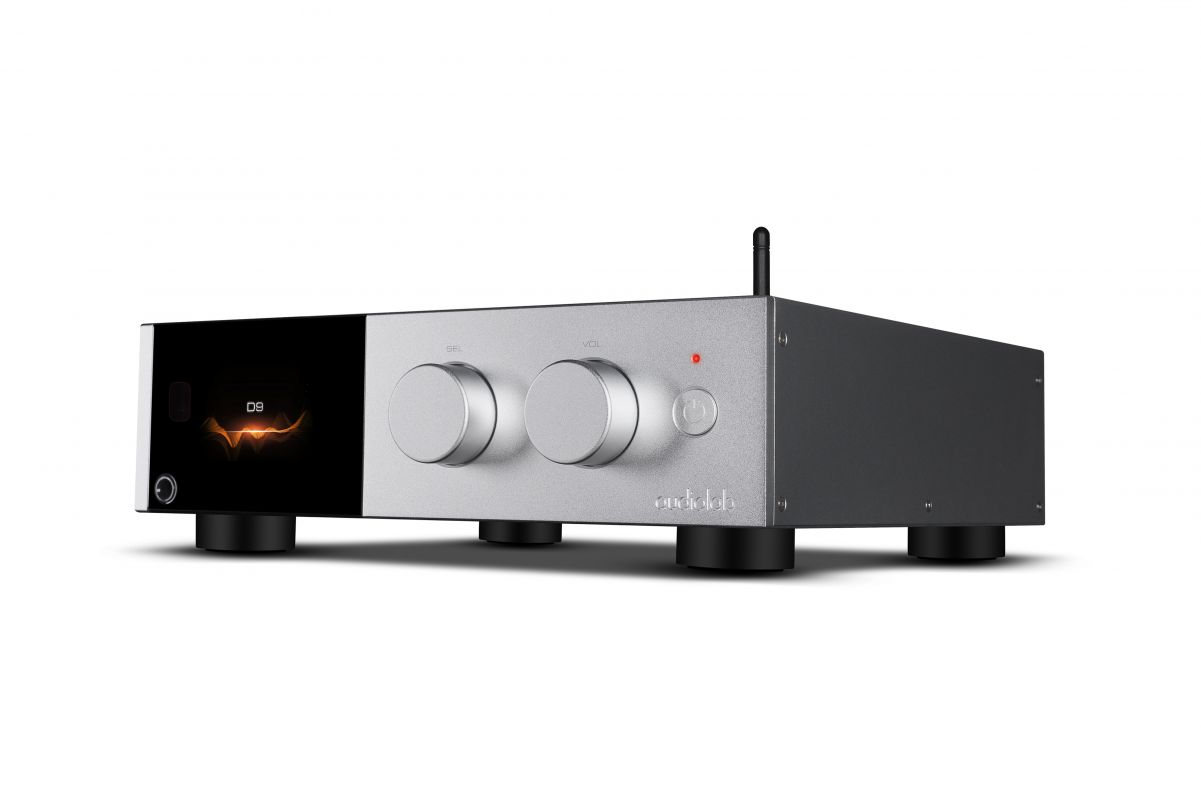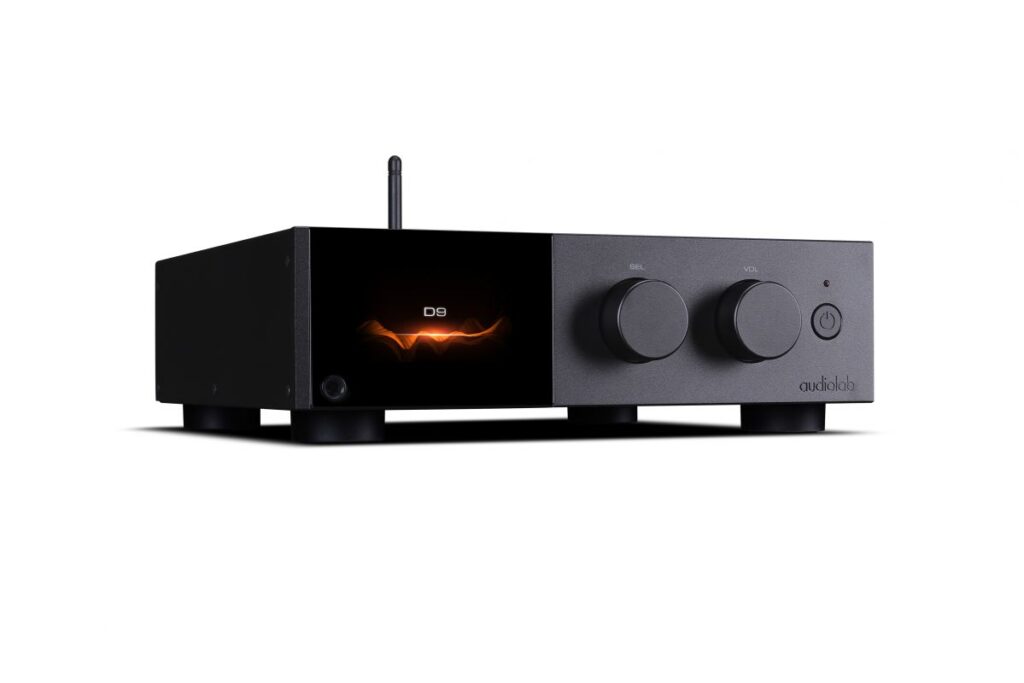
DAC's the way: the legacy continues...
Audiolab unleashes two new standalone DACs, the D7 and D9, directly descended from the seminal
M-DAC to enhance all manner of digital audio
While Audiolab has continued to refine the DAC (Digital-to-Analogue Converter) technology in its range
of amps and streamers, eight years have passed since the company last launched a standalone DAC
component. But, with the arrival of the D7 and D9, the next generation of Audiolab DACs is finally here.
Priced at £449 and £1099 respectively, the new DACs are direct descendants of the legendary M-DAC –
a seminal device that swept aside all before it, remaining dominant in the DAC world for over half a
decade. They build upon the same blueprint, honed over several generations of technical development.
Housed in a sturdy aluminium case measuring 180x56x208mm (WxHxD), the D7 is a compact DAC for
home use delivering a performance that belies its accessible price point. The D9 is a larger device
(albeit still smaller than a ‘full width’ hi-fi component) with dimensions of 315x88x277mm and
benefitting from the same technical, build and design qualities as Audiolab’s top-tier 9000 Series
amplification and streaming components.

Combining DAC, preamp and headphone amp functionality, both DACs are as accomplished at the
heart of a high-performance hi-fi system as they are on a desk for headphone listening.
D7 and D9: Continuing the M-DAC’s legacy
A key part of the M-DAC’s success was the use of ESS Technology’s then new and groundbreaking 32-bit
Sabre DAC technology. The ES9018 Reference DAC chip was introduced in 2009, and the M-DAC was one
of the very first DAC components to use it.
Left Forebears of the D7 and D9:
M-DAC (2011), M-DAC+ (2016) and
M-DAC Mini (2017)
When the M-DAC arrived in 2011, it proved to be a revelation – not just owing to this innovative chipset
but also because of the circuitry Audiolab designed around it. This ensured it made the most of the
ES9018 Reference’s attributes whilst eliminating the deleterious effects of sub-optimal implementation.
The range of Sabre DAC chipsets has since expanded and is now widely used by audio manufacturers,
but these chips remain challenging to implement to achieve optimal performance. While they are
capable of excellent resolution, products that use them can sound sterile if appropriate care is not taken
with the accompanying circuitry. Audiolab has more experience in working with these chips than any
other manufacturer, from the original M-DAC onwards, giving the company a significant advantage.
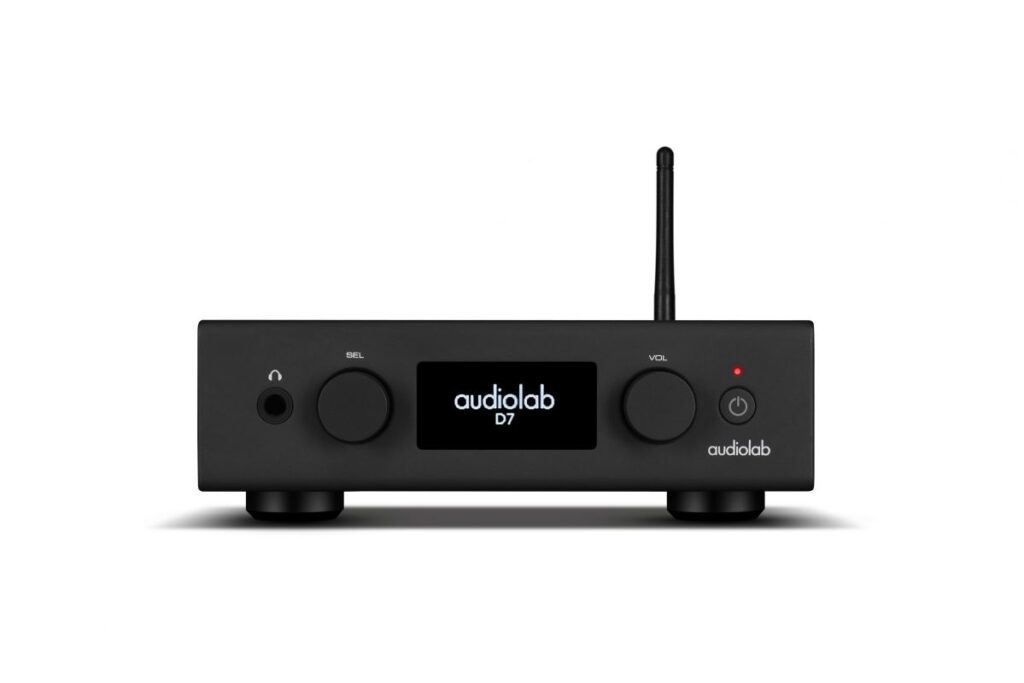
The new D7 is elegant on the outside
and sophisticated within
D7: A compact and affordable digital sound enhancer
The D7 is based around the ES9038Q2M – a high-specification Sabre DAC chip also utilised by Audiolab’s
7000A and just-launched 6000A MkII integrated amplifiers. This is accompanied by proprietary circuitry
to make the most of ESS Technology’s HyperStream II architecture and Time Domain Jitter Eliminator for
ultra-low noise and high dynamic range.
Proprietary clock and power supply circuitry elevates the DAC’s performance, alongside a Class A
post-DAC active filter – a critical element to the D7’s sound quality. Hi-res audio support is state-of-the
art, handling PCM to 32-bit/768kHz and DSD to 22.5792MHz (DSD512) via USB. Full MQA decoding is
also included and the D7 is certified as ‘Roon Tested’ for use in a Roon audio environment.
Designed to perform as a high-quality digital audio ‘hub’, the D7 offers a versatile connectivity suite.
Digital inputs include USB Type B to connect PCs, Macs and so on, and USB Type A for the direct
connection of USB drives (content from such drives can be navigated via the D7’s display). These are
joined by four S/PDIF inputs – two optical and two coaxial.
Left Despite its compact size, the D7 packs in an impressive connectivity suite at the rear.
Bluetooth is also included for convenient wireless reception from smartphones, tablets and the like,
with support for multiple codecs including aptX HD, and Bluetooth 5.1 compliance for optimum range
and speed. Listeners can opt to upsample digital audio data to 352.8kHz or 384kHz, while five DAC
reconstruction filter settings allow listeners to adjust the sound to suit the source material – particularly
useful given the variable quality of digital formats and streaming platforms.
Output options are also extensive, including balanced XLR and single-ended RCA on the analogue side,
plus optical and coaxial digital outputs. Headphones are catered for by a 6.3mm socket, and two 12V
trigger outputs can be used to power up/down connected devices in synchronicity with the D7.
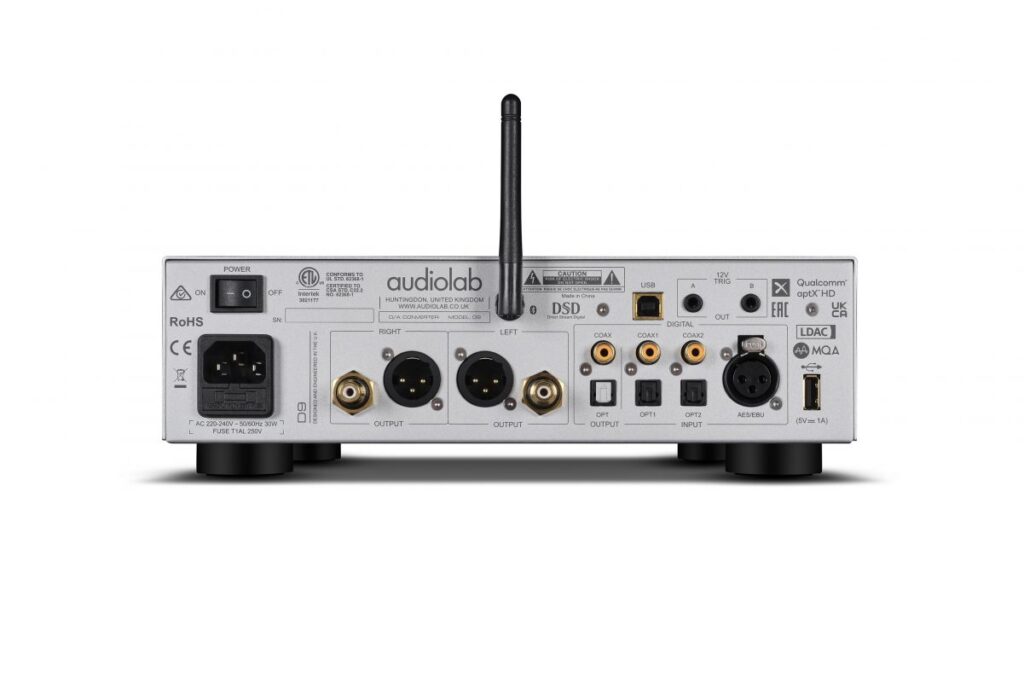
Left The D7’s circuitry builds on Audiolab’s long track record of developing class-leading DACs
The analogue outputs can be used in fixed or variable mode. The former allows connection to integrated
amps and preamps, with the amp controlling volume level, while the latter utilises the D7’s precision,
ultra-transparent volume control – this enables direct connection to a power amp or powered speakers.
Those with suitably equipped amps reap the benefits of a balanced analogue signal chain, thanks to the
DAC’s differential balanced architecture and XLR outputs.
The physical layout of the D7’s circuitry protects the audio signal from interference, enhanced by
independent low-noise power supplies for all critical stages fed by an offboard PSU. This rigorous
attention to detail, complemented by tactile rotary controls and a crisp, monochrome OLED display,
helps to deliver a combination of versatility and performance that outstrips the sub-£500 mains
powered DAC competition.
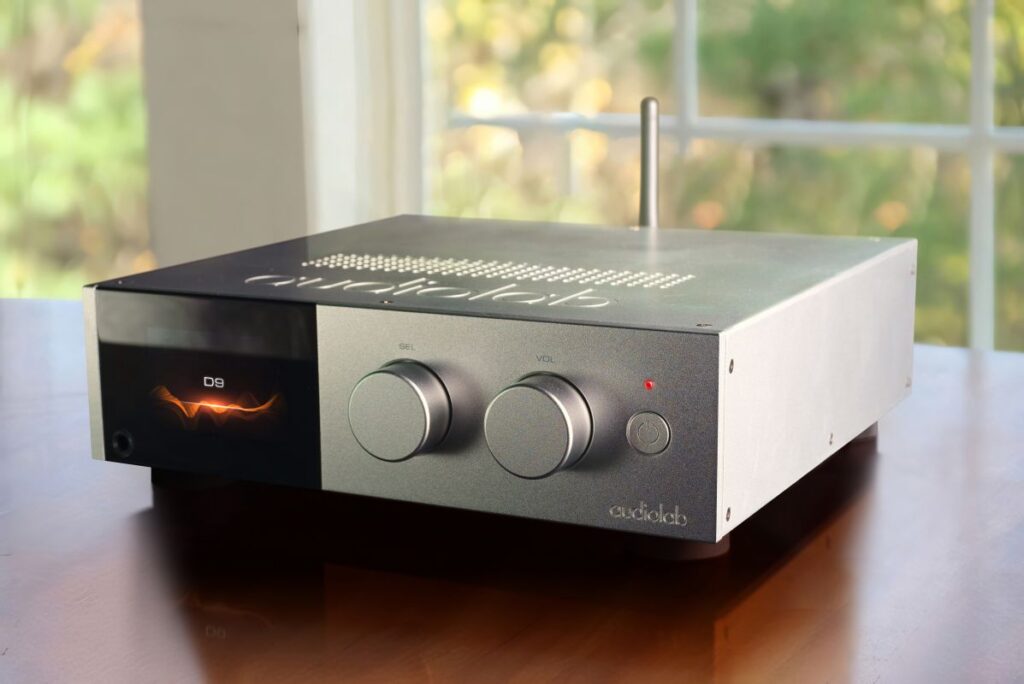
The premium-level D9 raises the quality bar still further in every respect – build quality, facilities and, of
course, sonic performance. Its affiliation with Audiolab’s flagship 9000 Series hi-fi components is clear
from the outset, with its crisply designed exterior and eye-catching colour display.
Technically, the D9 bears close comparison with Audiolab’s 9000N music streamer (£2500), shorn of the
onboard network streaming functionality but with everything else intact (plus Bluetooth added). At its
heart lies the ES9038PRO – a pre-eminent DAC chip from the top tier of ESS Technology’s current range.
While the ES9038Q2M used in the D7 is a two-channel chip, the ‘PRO’ version’s architecture incorporates
eight channels. The D9 utilises all eight of these to deliver a balanced stereo signal – four for the left and
four for the right – realising further benefits in the eradication of noise and distortion. This combines
with proprietary Audiolab circuitry including an ultra-precision master clock and Class A post-DAC filter
to deliver remarkable sonic clarity and breathtaking dynamics.
Left Premium design and build quality reflect the quality of engineering within he D9’s aluminium chassis
Like the D7, the D9’s impeccable hi-res credentials encompass PCM to 32-bit/768kHz and DSD to
22.5MHz (DSD512). Every significant hi-res and lossless audio format is catered for, including FLAC,
ALAC, AIFF, APE and WAV, as well as compressed legacy formats, alongside full MQA decoding. The same
user-selectable upsampling and digital filter settings are provided, enabling the listener to tune the
sound to suit the source material, and the D9 also has Roon Tested certification.
The D9’s audio circuitry is significantly elevated, as befits its premium status. The post-DAC analogue
circuitry incorporates top-grade components and a differential balanced architecture for maximum
signal purity. An expertly engineered linear power supply incorporates a 40VA toroidal transformer,
delivering clean, consistent power to all the sensitive parts of the digital and analogue stages.
Multiple discrete ultra-low-noise regulators provide power separately to the left and right channels for
each stage of the digital-to-analogue conversion process – a sophisticated topology born from
Audiolab’s experience of working with ESS Technology’s reference-class Sabre DAC chips.
Left While the D7’s circuitry is very highly specified at its price point, the D9 takes things to a whole new level.
The D9’s connectivity array adds an AES3/EBU digital input to the D7’s complement of asynchronous
USB-B, USB-A, two optical and two coaxial inputs. The D9’s Bluetooth implementation adds support for
Sony’s LDAC high-definition format, alongside aptX HD, aptX Low Latency, regular aptX, AAC and SBC.
Output options mirror the D7: balanced XLR and single-ended RCA (fixed and variable), plus optical and
coaxial digital outputs, a 6.3mm headphone socket and a pair of 12V trigger outs.
Left Extensive connectivity options ensure the D9 is at home in even the
most high-end of audio applications Solidly built and impeccably finished, the D9’s crisp lines are complemented by two rotary controls and a left-aligned 2.8in colour screen, mirroring Audiolab’s top-tier, full-width 9000 Series components but in a more compact form. The screen displays a variety of information including volume level, input selection, track information and format data. Various other options include a VU-style meter showing real-time decibel levels; the display can also be simplified, dimmed or turned off completely, as the user prefers.
D7 and D9: Heavenly with headphones
The D7 and D9 incorporate the same dedicated headphone amp circuitry, its current-feedback design,
wide bandwidth, high slew rate and low output impedance delivering a spacious, detailed and dynamic
performance with all manner of headphones – even tough loads that many DACs’ headphone outputs
struggle to drive.
Both DACs deliver 500mW into a 33-ohm load, with an output voltage of up to 4.8Vrms and maximum
output current of 180mA. In other words, both the D7 and D9 are capable of driving virtually any pair of
headphones, whether dynamic or planar, to seriously high volume levels – effortlessly and without a
hint of distortion.
Both these exciting DAC's will be on sale soon at £449 and £1099 respectively.
